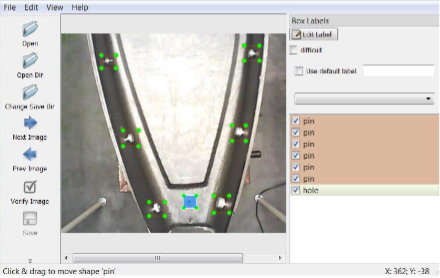Effect of Color Contrast to the Accuracy of SSD-MobileNetV2
Keywords:
Deep learning, industrial application, machine vision, SSD-MobileNetV2, visual inspectionAbstract
Machine vision with deep learning neural network is currently on the rise, specifically with the emergence of Industrial Revolution 4.0. It is further elevated with the advancement in the computational capabilities of modern edge computing to reduce the computational cost. Thus, making such technology economically viable to the general manufacturing industries for industrial application. Visual quality inspection would be among the most relevant process to have such architecture implemented. This paper explores the feasibility of deploying deep learning model, SSD-MobileNetV2 to replace manual visual inspection for holes counting process after drilling on a carbon-reinforced fiber composite component. The drilled holes were set into three (3) different conditions; bare-holes and holes equipped with semi-transparent or red locating pins. We conclude that the contrasting color of the holes with respect to its surrounding plays a pivotal role in their detections. Holes with semi-transparent or red locating pins are with accuracy of 77.14% and 73.33% respectively; while bare-blackened holes are with accuracy of only 45.95%.
Downloads
References
H. Golnabi, and A. Asadpour, “Design and Application of Industrial Machine Vision Systems,” Robotics and Computer-Integrated Manufacturing, vol. 23, Iss. 6, 2007, pp. 630-637, doi: 10.1016/j.rcim.2007.02.005.
Agarwal, D. A. . (2022). Advancing Privacy and Security of Internet of Things to Find Integrated Solutions. International Journal on Future Revolution in Computer Science &Amp; Communication Engineering, 8(2), 05–08. https://doi.org/10.17762/ijfrcsce.v8i2.2067
D. Unay and B. Gosselin, "Artificial neural network-based segmentation and apple grading by machine vision," IEEE International Conference on Image Processing 2005, 2005, pp. II-630, doi: 10.1109/ICIP.2005.1530134.
Pawan Kumar Tiwari, P. S. . (2022). Numerical Simulation of Optimized Placement of Distibuted Generators in Standard Radial Distribution System Using Improved Computations. International Journal on Recent Technologies in Mechanical and Electrical Engineering, 9(5), 10–17. https://doi.org/10.17762/ijrmee.v9i5.369
A. K. Bhatt, and D. Pant, “Automatic Apple Grading Model Development Based on Back Propagation Neural Network and Machine Vision, and its Performance Evaluation,” AI & SOCIETY, vol. 30, Iss. 1, 2013, pp. 45-46. doi: 10.1007/s00146-013-0516-5.
S. Albawi, T. A. Mohammed and S. Al-Zawi, "Understanding of a convolutional neural network," 2017 International Conference on Engineering and Technology (ICET), 2017, pp. 1-6, doi: 10.1109/ICEngTechnol.2017.8308186.
Chauhan, T., and S. Sonawane. “The Contemplation of Explainable Artificial Intelligence Techniques: Model Interpretation Using Explainable AI”. International Journal on Recent and Innovation Trends in Computing and Communication, vol. 10, no. 4, Apr. 2022, pp. 65-71, doi:10.17762/ijritcc.v10i4.5538.
K. O’Brien, and J. Humphries, “Object Detection using Convolutional Neural Networks for Smart Manufacturing Vision Systems in the Medical Devices Sector,” Procedia Manufacturing, vol. 38, pp. 142-147, 2019, doi: 10.1016/j.promfg.2020.01.019.
Y. Li, H. Huang, Q. Xie, L. Yao, and Q. Chen, “Research on a Surface Defect Detection Algorithm Based on MobileNet-SSD.” Applied Sciences, vol. 8, pp. 1678, 2018, doi: 10.3390/app8091678.
W. Liu, D. Anguelov, D. Erhan, C. Szegedy, S. Reed, C. Y. Fu, and A. C. Berg, “SSD: Single Shot Multibox Detector,” 2015, [Online] Available: https://arxiv.org/abs/1512.02325.
Dursun, M., & Goker, N. (2022). Evaluation of Project Management Methodologies Success Factors Using Fuzzy Cognitive Map Method: Waterfall, Agile, And Lean Six Sigma Cases. International Journal of Intelligent Systems and Applications in Engineering, 10(1), 35–43. https://doi.org/10.18201/ijisae.2022.265
Evan, M. Wulandari, and E. Syamsuddin, “Recognition of Pedestrian Traffic Light using Tensorflow and SSD MobileNet V2,” IOP Conference Series: Materials Science and Engineering, vol. 1007, 2020, doi: 10.1088/1757-899X/1007/1/012022.
Boyapati, B. ., and J. . Kumar. “Parasitic Element Based Frequency Reconfigurable Antenna With Dual Wideband Characteristics for Wireless Applications”. International Journal on Recent and Innovation Trends in Computing and Communication, vol. 10, no. 6, June 2022, pp. 10-23, doi:10.17762/ijritcc.v10i6.5619.
Tzutalin. “LabelImg,” Git code, 2015, [Online] Available: https://github.com/tzutalin/labelImg.
J. Huang, V. Rathod, C. Sun, M. Zhu, A. Korattikara, A. Fathi, I. Fisher, Z. Wojna, Y. Song, S. Guadarrama and K. Murphy, “Speed/Accuracy Trade-offs for Modern Convolutional Object Detectors,” 2016, [Online] Available https://arxiv.org/abs/1611.10012.
M. Sandler, A. Howard, M. Zhu, A. Zhmoginow, and L. Chen, “MobileNetV2: Inverted Residuals and Linear Bottlenecks,” Proceedings of the IEEE Conference on Computer Vision and Pattern Recognition (CVPR). 2018, pp. 4510-4520.
Gill, D. R. . (2022). A Study of Framework of Behavioural Driven Development: Methodologies, Advantages, and Challenges. International Journal on Future Revolution in Computer Science &Amp; Communication Engineering, 8(2), 09–12. https://doi.org/10.17762/ijfrcsce.v8i2.2068

Downloads
Published
How to Cite
Issue
Section
License

This work is licensed under a Creative Commons Attribution-ShareAlike 4.0 International License.
All papers should be submitted electronically. All submitted manuscripts must be original work that is not under submission at another journal or under consideration for publication in another form, such as a monograph or chapter of a book. Authors of submitted papers are obligated not to submit their paper for publication elsewhere until an editorial decision is rendered on their submission. Further, authors of accepted papers are prohibited from publishing the results in other publications that appear before the paper is published in the Journal unless they receive approval for doing so from the Editor-In-Chief.
IJISAE open access articles are licensed under a Creative Commons Attribution-ShareAlike 4.0 International License. This license lets the audience to give appropriate credit, provide a link to the license, and indicate if changes were made and if they remix, transform, or build upon the material, they must distribute contributions under the same license as the original.





